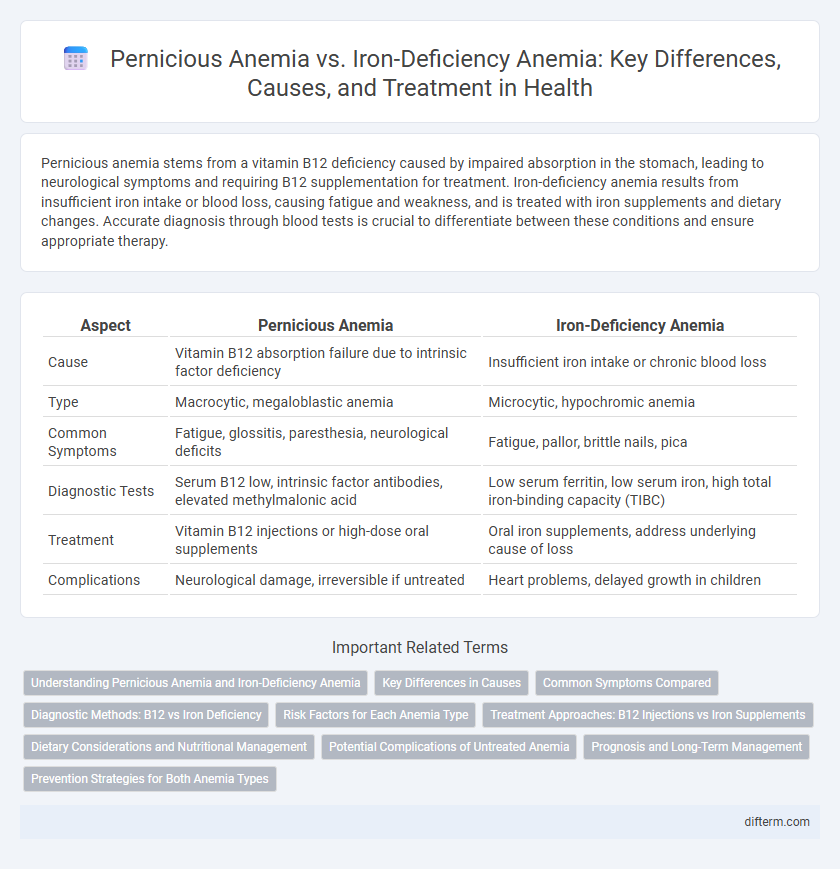Pernicious anemia stems from a vitamin B12 deficiency caused by impaired absorption in the stomach, leading to neurological symptoms and requiring B12 supplementation for treatment. Iron-deficiency anemia results from insufficient iron intake or blood loss, causing fatigue and weakness, and is treated with iron supplements and dietary changes. Accurate diagnosis through blood tests is crucial to differentiate between these conditions and ensure appropriate therapy.
Table of Comparison
| Aspect | Pernicious Anemia | Iron-Deficiency Anemia |
|---|---|---|
| Cause | Vitamin B12 absorption failure due to intrinsic factor deficiency | Insufficient iron intake or chronic blood loss |
| Type | Macrocytic, megaloblastic anemia | Microcytic, hypochromic anemia |
| Common Symptoms | Fatigue, glossitis, paresthesia, neurological deficits | Fatigue, pallor, brittle nails, pica |
| Diagnostic Tests | Serum B12 low, intrinsic factor antibodies, elevated methylmalonic acid | Low serum ferritin, low serum iron, high total iron-binding capacity (TIBC) |
| Treatment | Vitamin B12 injections or high-dose oral supplements | Oral iron supplements, address underlying cause of loss |
| Complications | Neurological damage, irreversible if untreated | Heart problems, delayed growth in children |
Understanding Pernicious Anemia and Iron-Deficiency Anemia
Pernicious anemia is a vitamin B12 deficiency caused by the body's inability to absorb this essential nutrient, leading to symptoms such as fatigue, weakness, and neurological issues. Iron-deficiency anemia results from insufficient iron levels, impairing hemoglobin production and causing symptoms like pallor, shortness of breath, and dizziness. Accurate diagnosis relies on blood tests measuring vitamin B12, serum iron, ferritin, and complete blood count to differentiate between these two common types of anemia.
Key Differences in Causes
Pernicious anemia is primarily caused by vitamin B12 deficiency due to the body's inability to absorb the vitamin, often linked to autoimmune destruction of stomach parietal cells. Iron-deficiency anemia results from insufficient iron intake, chronic blood loss, or malabsorption, leading to inadequate hemoglobin production. The key difference lies in their underlying causes: vitamin B12 malabsorption in pernicious anemia versus iron deficiency or loss in iron-deficiency anemia.
Common Symptoms Compared
Pernicious anemia and iron-deficiency anemia share common symptoms such as fatigue, weakness, and pallor due to impaired oxygen transport in the blood. Pernicious anemia uniquely presents with neurological symptoms like numbness, tingling, and balance issues caused by vitamin B12 deficiency affecting nerve function. Iron-deficiency anemia often results in brittle nails, spoon-shaped nails, and cravings for non-nutritive substances, reflecting the body's need for increased iron.
Diagnostic Methods: B12 vs Iron Deficiency
Pernicious anemia diagnosis relies on measuring serum vitamin B12 levels, intrinsic factor antibodies, and methylmalonic acid to confirm B12 malabsorption. Iron-deficiency anemia is primarily diagnosed through serum ferritin, transferrin saturation, and total iron-binding capacity (TIBC) tests that reflect iron stores and transport. Complete blood count (CBC) helps differentiate the two by showing macrocytic anemia in B12 deficiency and microcytic anemia in iron deficiency.
Risk Factors for Each Anemia Type
Pernicious anemia risk factors include autoimmune conditions such as Hashimoto's thyroiditis, a history of gastric surgery, and Helicobacter pylori infection that impairs vitamin B12 absorption. Iron-deficiency anemia risk factors involve chronic blood loss from gastrointestinal ulcers or heavy menstruation, poor dietary iron intake, and increased iron demands during pregnancy. Both conditions require targeted diagnosis due to their distinct etiologies and associated complications.
Treatment Approaches: B12 Injections vs Iron Supplements
Pernicious anemia requires Vitamin B12 injections to bypass impaired absorption caused by intrinsic factor deficiency, ensuring rapid restoration of healthy red blood cell production. Iron-deficiency anemia is effectively treated with oral or intravenous iron supplements that replenish depleted iron stores critical for hemoglobin synthesis. Timely identification of the specific anemia type guides targeted therapy, improving hematologic recovery and patient outcomes.
Dietary Considerations and Nutritional Management
Pernicious anemia requires vitamin B12 supplementation often through injections or fortified foods due to impaired absorption, while iron-deficiency anemia management focuses on increased dietary intake of heme iron sources such as red meat, poultry, and iron-fortified cereals combined with vitamin C to enhance absorption. Avoiding inhibitors like calcium, tannins from tea, and phytates during iron-rich meals is crucial for improving iron bioavailability, whereas pernicious anemia patients benefit from a diet that supports nerve health including folate and vitamin B6. Monitoring and adjusting dietary plans in collaboration with healthcare providers ensures effective correction of nutrient deficiencies and prevents anemia recurrence.
Potential Complications of Untreated Anemia
Untreated pernicious anemia can lead to severe neurological complications, including peripheral neuropathy, cognitive decline, and irreversible nerve damage due to vitamin B12 deficiency. Iron-deficiency anemia may cause heart problems such as tachycardia, heart failure, and increased risk of complications during pregnancy due to chronic oxygen deprivation. Both types of anemia, if left untreated, significantly raise the risk of fatigue, impaired immune function, and reduced quality of life.
Prognosis and Long-Term Management
Pernicious anemia requires lifelong vitamin B12 supplementation to prevent neurological complications and improve hematologic outcomes, with a generally good prognosis if treated early. Iron-deficiency anemia prognosis depends on identifying and correcting the underlying cause, with oral or intravenous iron therapy leading to full recovery in most cases. Both conditions demand regular monitoring of blood parameters to ensure effective long-term management and prevent relapse.
Prevention Strategies for Both Anemia Types
Preventing pernicious anemia involves ensuring adequate vitamin B12 intake through dietary sources like meat, dairy, and fortified cereals or supplements for at-risk individuals. Iron-deficiency anemia prevention prioritizes consuming iron-rich foods such as red meat, leafy greens, and legumes, along with enhancing iron absorption by pairing with vitamin C-rich foods. Regular screening for at-risk populations and addressing underlying causes like gastrointestinal disorders are essential strategies to reduce the incidence of both anemia types.
Pernicious anemia vs Iron-deficiency anemia Infographic

 difterm.com
difterm.com